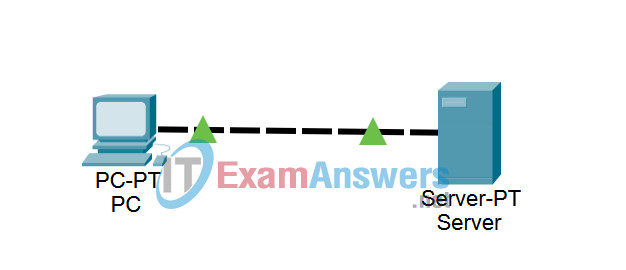3.2.3 Packet Tracer – Client-Server Interaction Answers
Topology

Learning Objectives
- Setup and run the simulation
- Examine the results
Introduction:
Clients, such as desktop PCs, request services from servers. The course lab environment, using actual PCs and servers, supports a full range of services. In a simulated environment, the number of services is limited. Packet Tracer allows the addition of simulated network servers that support DHCP, DNS, HTTP, and TFTP. Packet Tracer also supports the addition of simulated PCs that can request these services. This activity uses a simple network consisting of a PC connected directly to a server configured to supply DNS services and hosting a web page. The activity will track the flow of traffic when a web page is requested, the IP address of the web page is resolved and the web page is delivered.
Task 1: Setup and run the simulation
Step 1. Enter simulation mode
When Packet Tracer starts, it presents a logical view of the network in realtime mode. At the end of the yellow bar below the logical workplace is the Realtime tab. Behind and to the right of the Realtime tab is the Simulation tab. Click this tab to enter simulation mode.
Step 2. Set Event List Filters
In simulation mode, the default is to capture all events supported by Packet Tracer. You can limit what is captured by setting event list filters. We want to capture only DNS and HTTP events. In the Event List section, click the Edit Filters button. A list of available events is displayed with all of them selected. Select the check box Show All/None in the lower right. This will clear all of the checked boxes. Select the check box for DNS and HTTP to select only DNS and HTTP events. Click outside of the events window to close it. The Event List will now display only DNS and HTTP events when running the simulation.
Step 3. Request a web page from the PC
Packet Tracer provides simulated services on devices. You will open a simulated web browser on the PC and request a web page from the server.
Click the PC in the logical workspace. Click the Desktop tab and click the Web Browser button. A simulated web browser opens. Type www.example.com into the URL box and click the Go button to the right. Minimize the simulated browser window.
Step 4. Run the simulation
In the Play Controls section of the Simulation Panel, click the Auto Capture / Play button. The exchange between the PC and the server is animated and the events are added to the Event List. These events represent the request of the PC to resolve the URL to an IP address. The DNS server provides the IP address, upon the request for the web page from the PC. The server renders the web page in two segments, and the PC acknowledges the web page. A dialog box appears indicating there are no more events and provides information on the timing of the simulation. Click OK to close it.
Task 2: Examine the results
Step 1. Access a specific PDU
Restore the simulated browser window on the PC. Notice there is a web page displayed. Minimize the simulated browser window.
In the Simulation Panel Event List section, the Info column contains a colored box that provides access to detailed information about an event. Click the colored box in the Info column for the first event. The PDU Information window opens.
Step 2. Examine the contents of the PDU Information Window
The first tab in the PDU Information window contains information about the inbound and outbound PDU as it relates to the OSI model. Click the Next Layer >> button repeatedly to cycle through the inbound and outbound layers and read the description in the box below the layers to get an overview of how the exchange works.
Examine the PDU information for the other events to get an overview of the entire exchange process.
If you have additional questions about the exchange process, be sure to ask your instructor.
